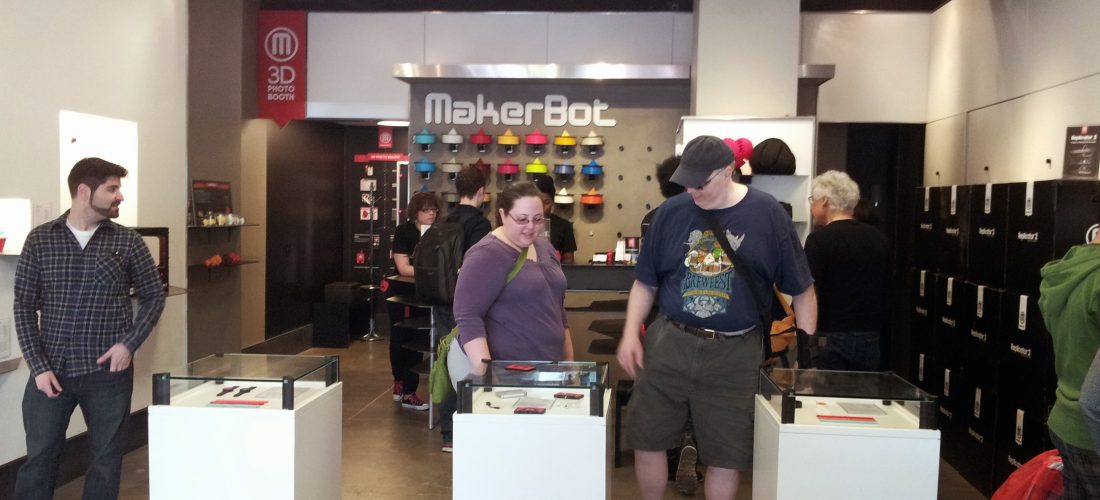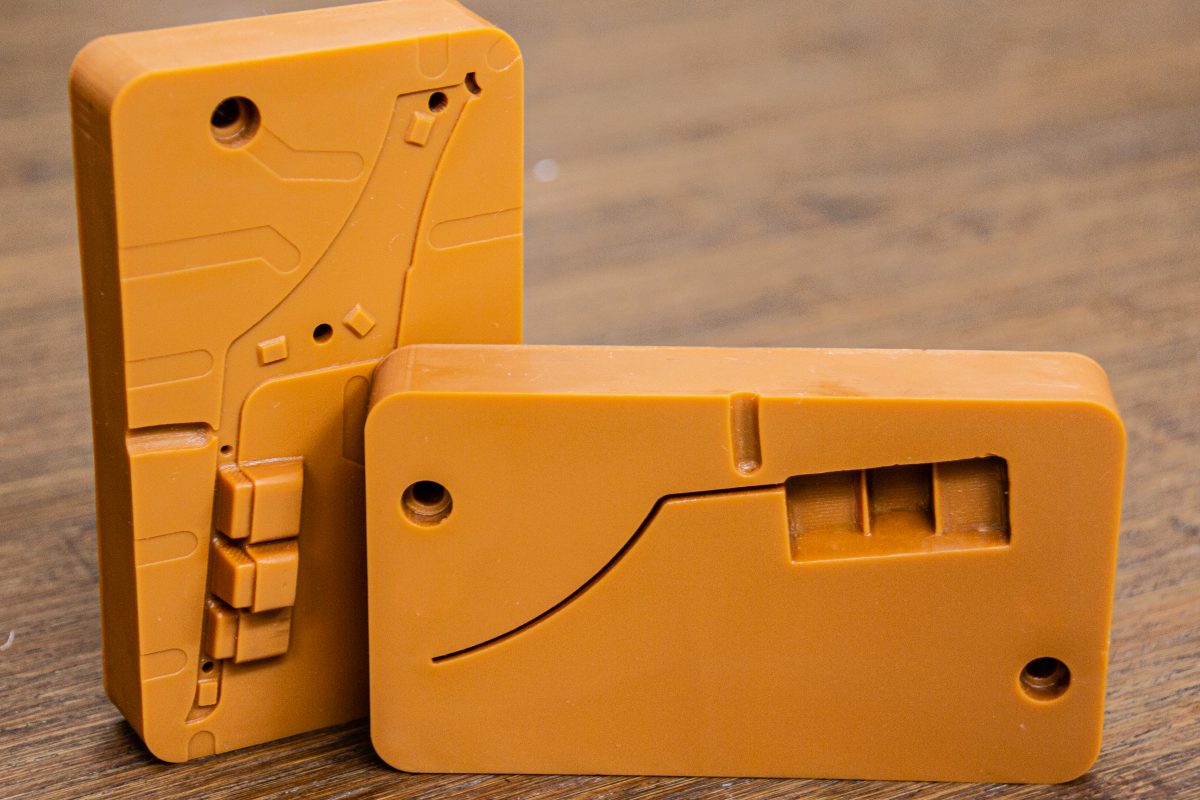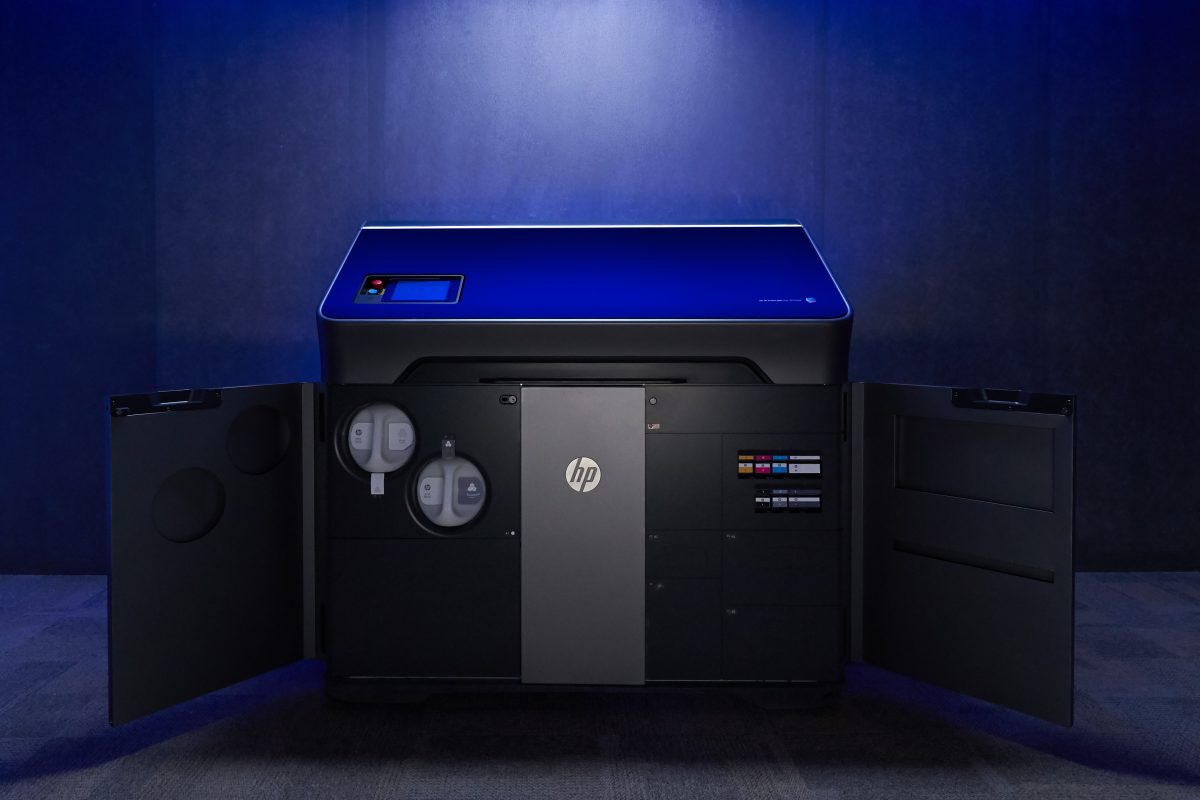A Bit of History
Back in 2013, I was in New York for TechCrunch Disrupt. I co-founded a startup called 3DLT, which began life as one of the industry’s first “for-pay” file marketplaces. Our business was less than six months old when we became the first 3D printing company to compete in Battlefield, the conference’s signature event.
While I was in Manhattan I made my first trip to the MakerBot store. The place was packed! Families were walking in with cash and walking out with 3D printers. Tourists were buying huge duffle bags at the luggage shops on Times Square and bringing them in. I saw one German man fit two MakerBot printers, which were still in the packaging, into one bag. I asked one of the employees what it was all about? She told me they weren’t shipping to Europe yet so people were checking them as luggage. It was surreal.
Two years later..
..I was back in New York for PrintWeek 2015. I was out with a customer and on a whim, we went to MakerBot’s party, which was being held at the store. The event was great, in part because they were serving Brooklyn Lager, which happens to be one of my favorites. As we walked out I grabbed one for the road. I never opened it and ended up bringing it back to the hotel. The next morning news broke that the MakerBot stores were closing.
I still have that bottle of Brooklyn Lager and every time I look at it, it reminds me of how quickly the market can change.
New Realities for desktop 3D Printing
I’ve talked with many desktop 3D printer manufacturers in the last year. Almost all of them have diversified beyond the consumer market. Education seems to be an opportunity for everyone. Others have carved out niches in automotive, aerospace, medical and other markets.
In the process of moving from crowdfunding and direct web sales to eCommerce and retail websites, and now into business-to-business sales through distributors and resellers, the makers of 3D printers have had to face some harsh realities. The expectations of retailers, schools and businesses are typically higher than those of consumers, especially early adopters.
Packaging Desktop 3D Printers
One of the first big eye-openers was that these new channels expected better packaging.
Online, unboxing videos and photos of packaging help confirm the value of a product. In-store, displays and packaging are directly responsible for selling it. There’s a reason Apple spends the kind of money it does on packaging.
It was huge news when MakerBot first went into Home Depot stores with desktop 3D Printing. To drive exposure, they were given valuable end-cap space. The 3D printers and filament were packaged in plain brown boxes. The display looked like something a kid might make for a science fair. Sales were lackluster at best. Poor marketing execution played a big role.
Even today, packaging is a second thought for many 3D printer manufacturers.
Consider this recent photo of how a 3D printer was actually delivered to an actual customer who bought online. I won’t even comment on how it was delivered, but if you’re going to ship a $1,000+ 3D printer, it’s probably best not to advertise the contents. And, if you tried to sell it in-store like that, you’d be facing the same problems MakerBot had at Home Depot.
how a 3D printer was actually delivered to an actual customer who bought online. I won’t even comment on how it was delivered, but if you’re going to ship a $1,000+ 3D printer, it’s probably best not to advertise the contents. And, if you tried to sell it in-store like that, you’d be facing the same problems MakerBot had at Home Depot.
In the end this just looks like a poor compromise. Packaging must be flexible enough to help market a product in-store, yet have a discreet option for direct shipment. Makers of TV’s and computers often use a “box within a box” approach.
Product Testing and Quality Assurance
Retailers aren’t the only ones who expect more from their suppliers. Resellers want to know the product has been tested and is safe.
To my knowledge, the Dremel Idea Builder was the first 3D printer to be UL and CE tested and approved. Prior to it, most printer manufacturers would use UL/CE approved components, but couldn’t or wouldn’t pay the significant cost of testing the assembled machine.
Dremel has significant experience with mass producing power tools and other consumer products. They know that testing and quality assurance are critical steps in the product development process. If they wanted to sell through retail and other channels, sooner or later someone would require proof that it was tested by a credible third party.
Schools have similar expectations. In the U.S., many distributors of educational products won’t even rep a product that hasn’t been UL tested and approved. Large school districts are buying dozens of printers at a time. In their bid documents, they often require verification of testing. Makes sense. They would have difficulty escaping liability if something happened and they didn’t attempt to confirm a product’s safety.
Warranty and Extended 3D Printer Service
When people buy equipment in a professional setting, the expect it to last as long as they plan to depreciate it. For a $1,000 machine, that’s typically 3 years. The standard warranty on most desktop 3D printers today is 3-6 months. The best I’ve ever seen is one year.
Furthermore to combat this issue, some manufacturers offer an extended warranty. But before we dive into that, let me digress on a few points.
First, I hate to keep on picking on MakerBot, but there’s a lot to be learned from their mistakes. The Smart Extruder was a train wreck. It was a $150 part that was considered a “consumable,” meaning it wasn’t covered under warranty. In some cases people were getting under 40 hours of print time before it would fail. Eventually that lead to a class action lawsuit.
Desktop 3D Printing Products in general, and new innovations specifically need to be thoroughly tested, or covered under warranty, or both. It’s tough to plan for and budget, but it has to be done. The threat of customer dissatisfaction is real.
Second, The idea of a $1,000+ desktop FDM printer is getting tougher to justify. If you belong to a 3D printing Facebook group, you’ve probably seen a post where someone is asking which is the best printer they can buy for under $300. A lot of people mock them, but keep this in mind:
Once is chance. Twice is coincidence. Third time’s a pattern.
How many of those posts have you seen? Customers are defining the pain threshold. Sooner than later, more companies will reach it. The successful ones must also deliver quality and reliability.
OK. Rant over. Whew.
Managing an extended warranty program for Desktop 3D Printing..
..is both a blessing and a curse. The good news is that it drives incremental revenue forward. You get the money now instead of later. The bad news is, you’ve got to figure out the cost of the program (and budget accordingly). You also have to manage the administrative side, including actuarial, sales, registrations, claims, legal, regulatory requirements and more. It’s not a core competency for most companies.
In other industries like power tools and consumer electronics, warranty work is often outsourced to third party administrators. They determine and commit to the cost of the program. They pay a share to the manufacturer as warranties are bought, and they pay more when parts and/or service are required.
It’s in their mutual benefit to sell the program, but they also take care of the administrative side. In the end, the manufacturer makes a little less than they would if they managed their own program, but…they get to focus on innovating, building and selling new machines.
Chicken and Egg
There are plenty of other areas where desktop 3D printer manufacturers can gain a competitive advantage. They have to learn from the past mistakes of others. Packaging is just one example.
But, they must also understand their core competency and work with others who can help them deliver a better experience. Business development, marketing, and product support are among the many opportunities.
Unfortunately, it often takes capital, which brings up the “chicken and egg” dilemma. You can’t manufacture and deliver a great product unless you have the capital to market and support it. Conversely, it’s difficult to get investment unless you’re already doing those things. Often, the best way to cheat the system is through mutually beneficial partnerships.
That’s it for now. Hope you liked my article. Maybe I’ll drop by again with some other thoughts (and probably another rant or two.) Have questions or an idea for a follow-up? Please share in the comments or hit me up on Twitter!
















